STRATEGIC AND OPERATIONAL CONCERNS
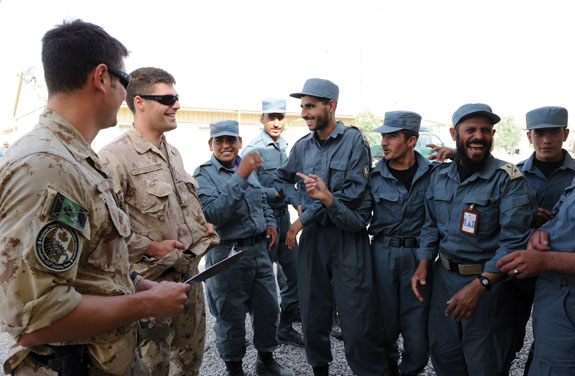
DND photo IS 2011-1041-05D Photo
CF Operational Mentor and Liaison Team (OMLT) members speak with Afghan National Police (ANP) recruits in Kandahar
Security Force Capacity Building: Local Ownership versus Human Capital
by Tyler Wentzell
Captain Tyler Wentzell, an infantry officer, recently completed his MA in War Studies from the Royal Military College of Canada (RMCC). In 2008, he deployed to Afghanistan as a company mentor for the Afghan National Army (ANA). There, he served as a trainer, mentored the ANA on independent operations, and facilitated partnered operations with Canadian, American, Portuguese, and British forces. From 2009 to 2011, he was second in command of the Security Force Capacity Building Centre of Excellence at the Canadian Manoeuvre Training Centre. He is currently studying law at the University of Toronto, and serving with the 48th Highlanders of Canada.
For more information on accessing this file, please visit our help page.
Introduction
Canadian Operational Mentor and Liaison Teams (OMLTs) working with the Afghan National Security Forces (ANSF) have recently brought attention to a key element of counterinsurgency operations: the development of host nation security forces. This process, known as Security Force Capacity Building (SFCB) in Canada, and Security Force Assistance (SFA) in the United States, is the predominantly military contribution to the wider Security Sector Reform (SSR) process. The Canadian Forces’ (CF) counterinsurgency doctrine emphasizes the utility of developing and working with host nation security forces due to their local knowledge, the perception of legitimacy they bring to the campaign, and, ultimately, their key role in providing lasting local solutions, thus allowing our own forces to withdraw.1 Their involvement is not, however, a cure-all. Inept, corrupt, or cruel indigenous security forces can be as much of a hindrance in counterinsurgency as effective forces can help. These forces will require varying degrees of guidance and direction. Afghanistan has proven to be an extreme example of this. Given the nation having endured decades of conflict, the human capital required for a professional police and army had been almost completely eliminated. More than the reform of the security sector, the Afghan campaign has required the nearly-total creation of a security apparatus. In the absence of the required human capital, intervening nations are forced to fill the void. This requirement, however, is at odds with another key element of SSR: the requirement for local ownership. This article proposes that the interplay between human capital and local ownership dictate the organizational model best suited to the development of these security forces, as illustrated at Figure 1.1. Although sublime elements such as local culture and traditions ensure that no two situations will be alike, these two key factors – human capital and local ownership – offer a useful tool in the selection of the models available in the development of the host nation security forces in humanitarian operations, peacekeeping, counterinsurgency, and high intensity operations alike.
Local Ownership and Human Capital
Local ownership is a strongly held concept among proponents of SSR. As one author defines it, “ …the principle of local ownership of SSR means that the reform of security policies, institutions and activities in a given country must be designed, managed and implemented by domestic actors rather than external actors.”2 The Organization for Economic Co-operation and Development (OECD) Development Assistance Committee (DAC) Handbook on SSR, the pre-eminent document on the subject, identifies local ownership, democratic governance, service delivery, and management and sustainability as the four goals of SSR.3 If we accept that any given military intervention abroad should eventually end, then local ownership is an obvious objective and a clear requirement for success. All military actions, particularly those directly involved in the development of host nation core security forces, should support this objective. Nonetheless, although ideal SSR activities will occur entirely on the initiative of and with the consent of the host nation, reality is somewhat different. First, as was the case in Afghanistan, the catalyst for SSR activities may be an invasion. The principle of local ownership becomes less clear when the SSR effort is also pursued in order to achieve donor-driven agendas. Second, the Geneva Center for the Democratic Control of Armed Forces reasonably asks, “… which locals?” Reforms may be resisted by the ruling elite who do not act in the best interests of their population, or in accordance with the values of the intervening nations.4 Third, the reforms required to bring about adequate and enduring security may simply be beyond the grasp of the host nation, due to a lack of human capital.
Human capital is the sum value of any organization’s competencies, knowledge, and skills.5 These skills are ultimately held by individual members within an organization, in this case, a host nation. As such, human capital differs from other forms of capital in that it can not only be destroyed, but it can also be displaced by the mass emigration that often accompanies violent conflict. The security sector requires considerable human capital. This includes bureaucrats to run the ministries, and lawyers and judges to maintain the judiciary. Most important to the discussion at present, human capital also includes the soldiers and policemen who not only hold the skills to exercise the state’s monopoly on violence, but also to implement the rule of law and to provide for the security of both the state and its people. In the case of Afghanistan, the human capital required for an effective security sector had all but been eliminated by the Soviet invasion and the ensuing civil war. An Afghan police force that enforced the rule of law was a long distant memory, and, in spite of the persistent fighting, the planning skills required of a modern professional army had similarly been wiped out. The reform of the Afghan security sector has therefore been intensive. Other interventions where the security sector holds greater human capital will require less dramatic development. It should be noted that the process of developing human capital should avoid the pitfall of ‘mirror-imaging.’
Although the donor nations have expertise to offer, the optimal security infrastructure for the host nation, and therefore, the required human capital, may be very different than that of the donor nations. The presence of greater human capital among the core security forces of the host nation will allow for increased local ownership that can be reflected in the force development model selected.
Five force development models based upon the relationship between human capital and local ownership are proposed. They are leadership, apprenticeship, partnership, mentorship, and technical support and training, and although they are not doctrinal terms, they each represent valid methods of developing security forces with historical precedents. These five models are offered as a spectrum (Fig. 1.1) to demonstrate that, as human capital is increased through training, experience, and education, local ownership can be increased as donor involvement in reform decreases. However, numerous other factors play a role. In the past, the models selected were primarily a reflection of other factors, including degree of compliance within the host nation, domestic support within the donor states, the resources of the donor states, the nature and regenerative capabilities of the enemy, and the presence and strength of donor state forces in theatre. Nonetheless, all other things being equal, the ideal development of a security force would be characterized by a smooth transition between models to increase local ownership as human capital increases. Such a transition would not only ensure maximum local ownership, but would reduce the risks of the host nation developing a dependence on the donor nations. Transition between models reflects this shift. An obvious problem with such an arrangement is that quantifying human capital and local ownership is a difficult if not an impossible task. This evaluation will be necessarily subjective depending upon the specific characteristic of the theatre in question. The remaining sections will discuss the five models offered, making use of historical examples.
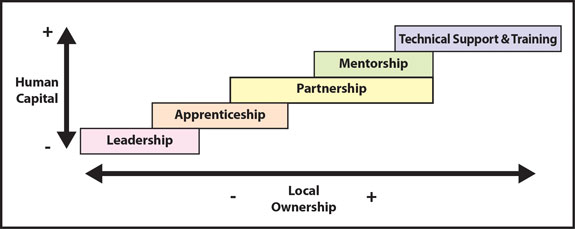
17 Wing Publishing Office
Figure 1.1
Leadership
The European powers of the 18th and 19th Centuries gained considerable experience in the processes of developing indigenous security forces. This development was born out of necessity. There simply were not enough European soldiers to go around, particularly in cases like The Netherlands, whose constitution prohibits sending conscripts on overseas assignments. Recruiting local soldiers and ‘officering’ them with Europeans ensured economy of effort and maintained maximum control over the force’s operations and general conduct. A widespread sense of racial superiority by the colonizers over the colonized contributed to a belief that the locals did not, in any event, hold the capacity for such responsibility. Such pompousness varied from one national experience to another – the French, for example, did not seek to ‘Europeanize’ their colonial soldiers and embraced the traditions and dress of their African colonies6 – but generally, the local forces were subordinated. The development of more-or-less European-style forces in the colonies was primarily a mechanism to maintain long-term control, and not to develop a given force’s capacity to plan and conduct independent operations.
The first model to be explored is leadership. In this model, the donor nation draws upon the manpower of the host nation, but supplements it by providing the leadership to command and to control the organization. Such a model allows for security forces to develop and become increasingly effective in many ways, but does not develop the leadership and planning capability to allow that force to stand on its own. Local ownership, even at the tactical level, is completely absent. Strong examples of this model were manifested in standing organizations, such as the German Schutztruppe, the British Indian Army, and the King’s African Rifles, andin hasty creations such as the European and American-officered Ever Victorious Army in China through the 1860s. In the British Indian Army, ‘natives’ could serve as Viceroy’s Commissioned Officers (VCOs), but they mostly fulfilled a liaison role. In spite of moderate reforms, such as allowing ten Indians per year to attend Sandhurst from 1918 onwards, and the 1932 opening of the Indian Military Academy, even as late as 1946, the officer corps of the Indian Army remained overwhelmingly British.7 Similarly, all officers in the Ghurkha regiments, actually part of the British Army, were strictly British or Commonwealth.8 In the German Schutztruppe, European leadership stretched even deeper, including, not only German officers, but also two German non-commissioned officers per company.9 Such colonial armies were not only effective in quelling internal uprisings, but also assisted in expanding their respective empires and defending the European homeland as late as the Second World War
Regardless of the expediency and efficiency of the leadership model, it holds considerable shortcomings. The model may be useful in cases where human capital within a given security sector is exceedingly low. However, this model makes no investment in the creation of the human capital required for indigenous and sustainable security, short of the development of basic soldier skills. Unless transition towards the other models is pursued, the force created will be ill-prepared to provide its own security. Take, for example, the case of Uganda, where this transition did not occur. In 1962, the King’s African Rifles had only two Ugandan officers. Idi Amin, virtually illiterate and already accused of human rights violations in Kenya, was one of those two officers.10 Uganda abruptly lost the skills and experience of the British officers, and lacked the human capital to compensate. The lack of human capital, and therefore, competition among the military leadership, played no small part in Amin’s meteoric rise to power. The progressive development of human capital in order to facilitate local ownership is an obvious requirement of SSR.
This brings us to the second model: apprenticeship.
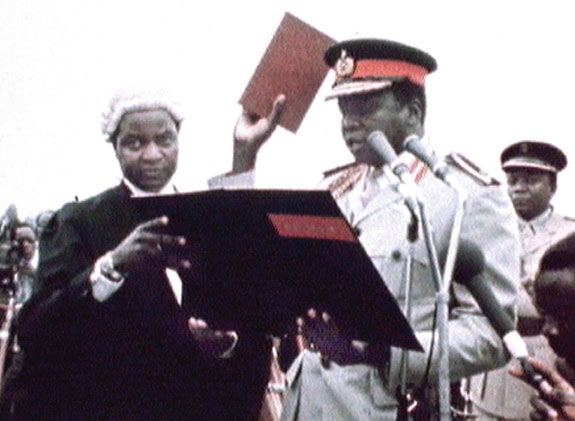
Reuters RTR1R1Y by Reuters TV
Former Ugandan dictator Idi Amin being sworn into office, 1971.
Apprenticeship
Apprenticeship is similar to leadership in most respects. As with the leadership model, the host nation provides the bulk of the manpower, while the donor nation provides the leadership to these forces. The difference is that the intervening nation intends upon developing and training the local leadership and surrendering control when the security situation and the human capital within the force permits. The desired end state is stability, not necessarily control. The overlap and eventual transition from leadership to apprenticeship is obvious. Probably the best example of the apprenticeship model was exhibited by the United States Marine Corps (USMC) during its various interventions throughout Central America in the enforcement of the Monroe Doctrine and the Roosevelt Corollary. Upon coming ashore, the Marines would create a paramilitary organization, dubbed a constabulary, and appoint Marine Corps officers to the leadership positions. During the hunt for Augusto César Sandino in Nicaragua, 93 Marine Corps officers provided the leadership for 1136 Nicaraguan soldiers.11 This model was exercised in Panama, Nicaragua, Haiti, and the Dominican Republic, often on more than one occasion in each country. The effectiveness of the constabulary model was institutionalized by the timeless 1940 USMC Small Wars Manual.
This manual dedicates an entire section to the constabulary model. It states that, upon intervention in a foreign country, the government of the United States takes responsibility for the protection of the citizens and the property within that country. As such, it must fulfill the security functions normally performed by police and military organizations that have probably disintegrated. This will not, however, be a permanent arrangement. The creation of a constabulary “… is one of the most important functions of the intervention.”12 The officers of the constabulary will initially be Marine Corps or Navy officers, or senior non-commissioned officers, until, “… as the domestic situation becomes tranquil and the native members of the constabulary become proficient in their duties, the United States officers of the constabulary are replaced by native officers.”13 The constabulary model certainly offers an appealing option for short-term stability and medium-term capacity building, particularly in a host nation without a tradition of standing security forces, or where the leadership of these forces is unacceptable to the intervening nation. The donor nation holds significant control over the selection and training of the force’s leaders, potentially sidestepping significant issues such as the institutionalization of a meritocracy, and the eradication of corruption and nepotism. Its downsides, of course, are not insignificant, including potential stunting of the growth of the local military leadership, the perception that the forces are nothing more than ‘puppets’ of the donor nation, and the domestic public perception of an ‘imperial’ agenda.
The remaining three models – partnership, mentorship, and technical support and training – have risen to prominence since the end of the Second World War. This is largely due to domestic resentment of actions viewed to be imperial in nature, and also the Cold War requirements for coalitions and of engaging in warfare by proxy. Following the Second World War, the United States established Military Assistance Groups (MAGs) and Military Advisory and Assistance Groups (MAAGs) in Greece, the Philippines, Taiwan, Iran, Japan, and Korea in order to bolster their security sectors. Additionally, Foreign Internal Defence (FID) became one of the six core tasks of the US Army Special Forces;14 a dedicated American unit assigned the task of developing host nation security forces. The Soviet Union pursued similar initiatives within their sphere of influence. Even as late as the tenure of Mikhail Gorbachev, Soviet advisors and trainers were heavily involved in developing the security forces in Syria, Ethiopia, South Yemen, and Afghanistan.15 Soviet allies, in turn, pursued similar missions elsewhere, such as the Vietnamese intervention in Cambodia, and Cuban involvement in the crises in Angola and Mozambique. By September 1965, in response to increased American involvement in Southeast Asia, the Soviet Union had more than 1500 advisors in North Vietnam, and more than 2600 North Vietnamese personnel were sent to the USSR for training.16 Wherever a flare-up occurred during the Cold War, American and Soviet advisors could surely be found, and generally at arms length.
Partnership
The next model to be discussed is partnership. This is a more nebulous concept than the other models offered. A partnered unit, in American doctrine, “… is a unit that shares all or a portion of an area of operations with a host nation security force unit.”17 Partnering as a concept has recently become very popular in Afghanistan and in Iraq. It implies a certain synergy that is very attractive, and it certainly falls within the spirit of existing counterinsurgency doctrine. In a recent directive, the Commander ISAF, General David Petraeus stated: “Partnership is an indispensable aspect of our counterinsurgency strategy. It is also an indispensible element of the transition of security responsibility to ANSF.”18 True partnership, however, where two groups ‘share everything,’ is problematic. Ultimately, unity of command requires that one of the commanders is the final authority for all decisions made. Collaboration in these decisions is certainly possible, but will primarily be the result of the personalities involved and the relationships they form. Consequently, true partnership will be generally unachievable, although degrees of partnership remain a valuable tool in the development of security forces. Partnership, in many respects, constitutes a pseudo-command relationship between two forces.
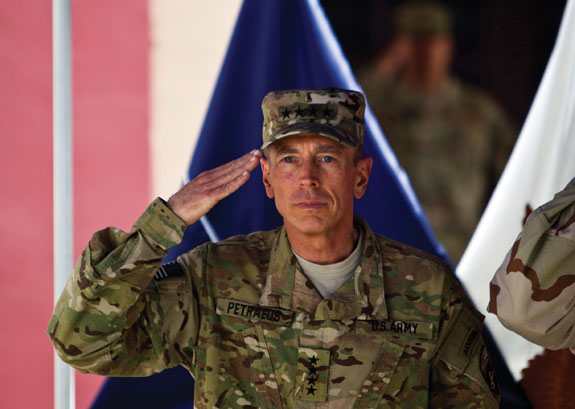
Reuters RTR2P0A7 by Ahmad Masood
General David Petraeus
Partnership can occur at numerous levels, and it remains suitable for host nation security forces with varying levels of human capital, hence the length of its representation at Fig 1.1. On one hand, partnership may be suitable for an indigenous force of extremely low human capital. Partnering with a similar, more developed force permits the local forces to access a larger number of trainers, as well as their partnered unit’s fire, intelligence, and logistic support. This support will be significantly greater than what can be provided by a comparably small, embedded, mentor team. Conversely, in a more advanced security force organization, such a level of support may not be necessary. Planning responsibilities and intelligence may be shared, but fire and logistic support will occur via two distinct but parallel chains.
One of the most noteworthy examples of partnership can be found in the USMC Combined Action Program (CAP) during the Vietnam War. Under this program, a squad of Marines was embedded in a roughly platoon-sized grouping of South Vietnamese Popular Force (PF) soldiers, locally recruited soldiers with limited training. The Marines were initially hand-picked for the assignment, ensuring the right personality types were selected for a task which required the two groups to ‘share everything.’ They lived together, worked together, and fought together, and although casualties among Marines in the program were statistically higher, so was their likelihood of requesting extended tours.19 This grouping was impressively successful in developing formidable bonds among the soldiers and the populace. Also, from anecdotal evidence, it appeared to be successful in increasing the government’s hold over the regions where the program was in place, and in improving the competence of the PF.20 Although this is how the model is best remembered, between 1968 and 1970 this ‘static’ CAP model gradually changed to a ‘roving’ CAP, wherein the USMC squads would rotate among two-or-more villages and PF units. Although the rationale for this shift was the reduction of available resources, such a shift in models could be used in the future in response to the developing capacity of the host nation security force unit.
Mentorship
The development of the partnered host nation security force is unlikely to be the only task assigned to a unit. Modern counterinsurgency campaigns are characterized by numerous parallel lines of operation. Commanders may find themselves in the difficult position of juggling a full set of assigned and time sensitive responsibilities, while simultaneously striving to fulfill their long-term standing task of developing their partnered host nation security force unit. Success in implementing this balancing act is no mean feat. Thus, it has shown beneficial for these partnered units to eltablish dedicated mentor teams, or for mentor teams to exist under a separate command. Such teams, in the form of NATO OMLTs, or American Embedded Training Teams (ETTs) in Afghanistan, and various forms of Transition Teams in Iraq, have met with success.
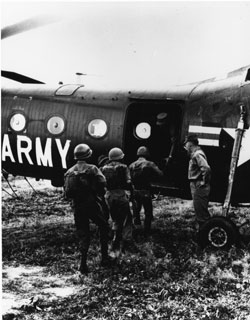
VA058541 by SP5 Edminton. US Army Aviation Museum Volunteer Archivists Collection, The Vietnam Center and Archive. Texas Tech University.
US Army advisors show South Vietnamese troops how to board a CH-21 helicopter, 1962.
Mentors or advisors will conduct operations with an assigned host nation security force unit.21 There is no command relationship: progress through mentorship will be made through perceptions of credibility, mutual respect, and the development of positive personal relationships.22 Mentorship normally consists of embedded teams of specialized trainers with the experience and skills necessary to develop the human capital of the organization while conducting operations. Mentorship on its own poses less of a burden on manpower than partnership, and due to the small size of a typical mentor team, the risk of the host nation unit developing a dependence on foreign aid is lessened. However, dependence upon certain modern enablers held by the donor nation remains an acute danger, particularly when these same enablers are not developed within the host nation security force. One of the most famous examples of mentorship, with no shortage of bribery and bluff, was the case of T.E. Lawrence (Lawrence of Arabia). Less romantic but probably more applicable examples also exist.
The conflicts in Korea and Vietnam provide illustrative examples of the mentorship model. In South Korea, the United States created the Military Advisory Group to the Republic of Korea (KMAG) to develop the capacity of the Republic of Korea Army (ROKA). KMAG provided mentors that initially assisted their ROKA counterparts in the development of an internal defence capability, and participated in ROKA combat operations against guerrillas. However, when North Korea invaded the South in June 1950, the mentors were ordered to withdraw, although not all of them did so. Subsequent events resulted in a new mandate that allowed the trainers to function as mentors in the conventional conflict. KMAG fulfilled its mentorship and liaison task throughout the war, maintaining its “advise-and-assist, do-not-command” policy, even during the darkest days.23
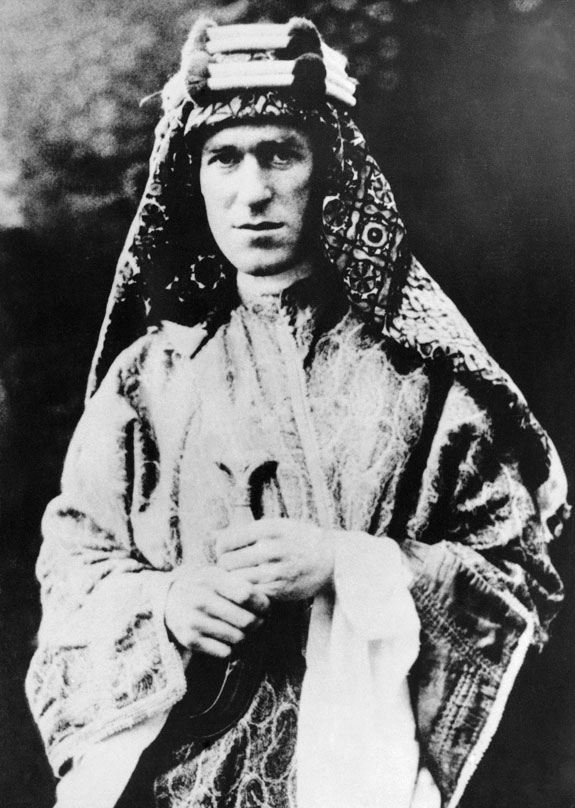
Associated Press APHS265833
Lawrence of Arabia, 1928.
In an intriguing blend of methods, the ROKA was further developed through other means. As one aspect, the United States provided the overall leadership for the war. With South Korean permission, the United States military took command of the war effort, and it has maintained command of the ROKA ever since, until the expected handover in 2012. The American Field Training Command was established in July 1951, and, almost immediately, began rotating ROKA units through training camps where they would receive much needed training from the individual to battalion level.24 Additionally, 30,000-40,000 ROKA soldiers were used to augment the American forces, sometimes partnered with American soldiers at the individual level, sometimes placed in separate platoons under American leadership. The quality of the ROKA soldiers, little more than recruits, was generally low, but, in time, they proved to be valuable in fulfilling security, reconnaissance, and general labour duties.25 Despite the intensity of the combat that the ROKA, and, by extension, that their KMAG mentors faced, few histories of the war provide much attention to their contribution. Tragically, the mentorship task has become the forgotten task of the forgotten war.
The Vietnam War offers a similarly useful example of mentorship. The American mission began as it ended, with teams of trainers and mentors. Beginning with US Army Special Forces teams, the mentorship effort was marginalized when the war was ‘conventionalized’ in 1965. Mentorship operations returned to the forefront in 1968, when General Creighton Abrams instituted his “one war” policy, calling for the development of the Republic of Vietnam Armed Forces (RVNAF) and better integration with American units. In 1969, the newly elected American President, Richard Nixon, instituted his policy of ‘Vietnamization,’ a policy aimed at putting the war back in the hands of the Vietnamese.26 The relationship between the American military and the RVNAF therefore changed frequently over the course of the war, and although the ultimate outcome of the conflict makes it popular to overly criticize the mentorship effort, it should be noted that the task was not without its successes, such as the aforementioned USMC CAP and the US Army Special Forces’ development of Civilian Irregular Defence Groups (CIDGs). Additionally, many of the elite Army of the Republic of Vietnam (ARVN) units fought surprisingly well during the Tet Offensive in 1968.27 Nonetheless, the effort to develop the RVNAF suffered from serious divisions. As the war evolved and American combat forces were introduced, RVNAF units were increasingly given a simpler pacification task, while American units pursued combat operations. Unlike in Korea, the US Army did not formally take command of the war effort, and integration between RVNAF and American units was limited. Until the “one war” was pursued, they very much fought separate wars.28 The overall effect of this neglect was evident during the failure of Operation Lam Son 719, the 1971 incursion into Laos. American mentors and combat units alike could not accompany the RVNAF, and the operation indicated that the RVNAF had grown dependent upon their counterparts. It was a tragic taste of things to come.
The mentorship model shows certain strength and weaknesses. Mentors operating in isolation have decreased influence over their counterparts. Personality is critical whenever working with host nation security forces, but it becomes especially critical in the mentorship model. Also, it appears that in cases where the human capital of the host nation security forces is low, mentorship is complimentary to partnership. In Korea, American and ROKA units shared common tasks. In Vietnam, for the most part, they did not. Even if not partnered in the formal sense, working together provides the host nation security forces with an example to emulate and support to draw upon while the mentors focus upon their specific tasks. In Korea, this unity of command was facilitated by the existence of a single, overall commander. The two armies functioned as one. From the examples provided, it is also important to note that mentorship can occur at any level. The ROKA tended to be mentored at the regimental level, whereas the Afghan National Army is currently mentored at the company and battalion level.29 In the case of Vietnam, the proportion of mentors within the ARVN ebbed and flowed in reflection of the other events of the war. Ideally, the proportion of mentors will not be a reflection of manpower constraints, but of a deliberate effort to gradually decrease increase local ownership as human capital within the force is developed. Units should graduate from a high-to-low proportion of mentors as the host nation security force increases in proficiency.
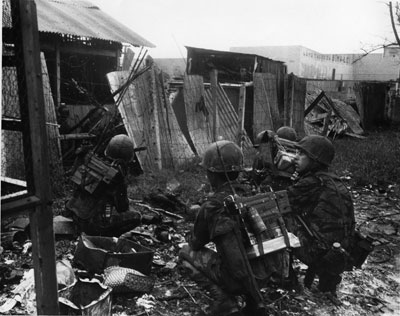
VA004194. The Douglas Pike Photograph Collection, The Vietnam Center and Archive, Texas Tech University.
Gia Dinh, Vietnam. An ARVN company commander, accompanied by an American advisor (right), lead an assault on a rice warehouse occupied by North Vietnamese soldiers.
Technical Support and Training
Not all efforts to develop host nation security forces will necessarily require involvement in combat operations. Indeed, most will not. This brings us to the fifth and final model: technical support and training. This model is most effective when employed with a host nation security force with high human capital – the effort being mostly to refine their existing skills – or when a low-cost and low-risk intervention is desirable. Most technical support and training missions will be characterized by teams, or even individual specialists who provide the host nation security forces with training and instruction. This interaction will occur within a secure area, the specifics of which will change depending on the absence or presence of a conflict and its intensity. In general, training missions are relatively low-cost and low-risk, making the endeavour an appealing method of shoring up security in a specific region. Although these trainers may go ‘outside the wire’ from time-to-time, their primary role is not in the conduct of operations – although they may assist in planning – but in the conduct of training.30 Although the low cost and risk of these operations is certainly attractive, there are several limitations that are well-illustrated by the case of the American training efforts in El Salvador during the insurgency of the 1980s.
Largely due to public fears of ‘another Vietnam,’ American trainers in El Salvador were restricted to a technical support and training role.31 Additionally, the Salvadoran military held high human capital, making the force seemingly well-suited for a high degree of local ownership. The El Salvadoran Armed Forces (ESAF) had a long history of a standing army, and a professional, in most senses, officer corps. It also had a long history of human rights violations and control of the central government, a critical failing that required reform. The American Military Advisory Group’s (MILGP) task was to provide training and specialist support to the ESAF from within the confines of secure camps. Such a restriction required that high numbers of Salvadoran personnel attend training in the United States, at the School of the Americas in Panama, and at the Regional Military Training Center in Honduras. Through such training, the MILGP was able to improve the ESAF’s competence as a force, and to reorient the ESAF’s actions towards the conduct of counterinsurgency operations.32 Nonetheless, corruption and nepotism remained commonplace, along with numerous human rights infractions. In 1981, more than 10,000 political murders occurred at the hands of the ESAF or affiliated death squads. By 1990, that number had been reduced to 108, a reduction that can likely be credited to American trainers.33 The ‘death squads’ de-legitimized the ESAF in the eyes of their own people, and eroded American public support for the mission. There can be little doubt that such actions could have been reduced sooner, had American advisors been able to mentor their ESAF counterparts on operations. Although the ESAF held high human capital in many senses, they lacked the professionalism to implement the rule of law, and to ethically enforce the government’s monopoly on violence. In terms of the objectives of the American intervention, the ESAF did not possess the human capital required for the level of local ownership they were afforded.
Conclusion
The five models discussed are not mutually exclusive. A great amount of flexibility is required as circumstances change. More than one model can be employed simultaneously and at various levels, depending upon the competence of the host nation security forces being developed. Take, for example, the Korean experience… The ROKA was developed through a combination of all five models, and has developed into a modern and professional force. A ’one size fits all’ approach is unnecessarily restrictive, and it does not allow the flexibility required to permit a host nation security force unit to develop its capabilities. When creating a strategy for the development of a security force, all of the aforementioned models should be considered, taking into account the human capital held by the host nation. Logically, a host nation and its security forces possessing high human capital will require less training support than a mediocre one. Additionally, the competency of a security force is unlikely to be uniform. Perhaps one unit will be in such disrepair that it will require partnership with a coalition unit down to the platoon level, drawing upon the coalition force’s logistic support in the short term, while a second unit requires nothing more than an embedded mentor team at the battalion level. Ultimately, the goal of host nation security force development is to create a force that is capable of conducting independent operations and bringing about enduring security. This will only be achievable if host nation security force units, as they graduate from one milestone to the next, are encouraged and allowed to take on increasing degrees of local ownership.
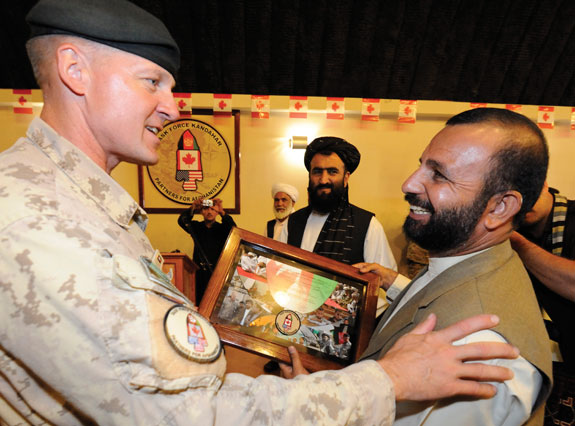
DND photo IS 2011-1037-17
Commander TF Kandahar presents Daman District Leader with a gift following the Transfer of Command Authority Ceremony
The development of host nation security forces is not a new development. Military professionals have been called upon to develop other armies since antiquity; such duties should be viewed as standing tasks, and not as aberrations. With growing experience in the field of host nation security force development, and the ability to draw upon the experiences of our allies, the methods of developing these forces merit further examination and discussion. This discussion should not shy away from the difficult debate regarding the competence and human capital of the security forces with whom we will work. Clearly, if they were proficient, they would not require reform. An honest and open evaluation of the calibre of these forces is necessary in order to determine the level of assistance required. Five potential models for this development process have been proposed. Using an honest assessment of human capital, these models can be applied in a phased manner so as to permit the greatest amount of local ownership possible, and to increasingly develop the host nation’s capabilities without creating undue dependence. The relationship between human capital and local ownership is a reality of security force assistance that must be addressed and constantly re-evaluated throughout the process.
Notes
- B-GL-323-004/FP-003, Counter-Insurgency Operations (Ottawa: Department of National Defence, 2008), pp. 5-1, 5-26, 5-37.
- Laurie Nathan, “The Challenge of Local Ownership of SSR: From Donor Rhetoric to Practice,” in Local Ownership and Security Sector Reform, Timothy Donais (Ed.) (Geneva: Geneva Centre for Democratic Control of Armed Forces Yearly Book Series, 2009), p. 21.
- OECD DAC, Handbook on SSR: Supporting Security and Justice (2007), p. 72.
- Alex Martin and Peter Wilson, “Security Sector Evolution: Which Locals? Ownership of What?” in Donais, p. 84.
- Human Capital definition from BusinessDirectory.com at: http://www.businessdirectory.com/definition/human-capital.html, accessed August 2010.
- Douglas Porch, “Bugeaud, Gallini, Lyautey: The Development of French Colonial Warfare,” in Makers of Modern Strategy: From Machiavelli to the Nuclear Age, Peter Paret (Ed.) (Princeton, NJ: Princeton University Press, 1986), p. 377.
- Partha Sarathi Gupta, “The Debate on Indianization 1918-1939,” in The British Raj and its Indian Armed Forces, 1857-1939, Partha Sarathi Gupta and Aniuudth Despande (Eds.), (New Delhi: Oxford University Press, 1986), p. 229.
- Byron Farwell, The Gurkhas (New York: W.W. Norton, 1884), p. 116.
- Ross Anderson, The Forgotten Front: the East African Campaign 1914-1918 (Wiltshire, UK: Tempus Publishing, 2004), p. 26.
- Martin Meredith, The State of Africa: A History of Fifty Years of Independence (London: The Free Press, 2005), p. 231.
- Max Boot, The Savage Wars of Peace: Small Wars and the Rise of American Power (New York: Basic Books, 2002), p. 236.
- Small Wars Manual (Washington: Department of the Navy, 1940), p. 12-3.
- Ibid., p. 12-9.
- FM 3-05, Army Special Operations Forces (Washington: Department of the Army, 2006), p. 24.
- Mark N. Katz, Gorbachev’s Military Policy in the Third World (New York: Praeger, 1989), p. 14.
- Ilya V. Gaiduk, The Soviet Union and the Vietnam War (Chicago: Ivan R. Dee, 1996), p. 60.
- FMI 3-24.2, Tactics in Counterinsurgency (Washington: Department of the Army, 2009), p. 12.
- General Petraeus Issues Updated Tactical Directive: Emphasizes ‘Disciplined Use of Force.’ In ISAF Official Website (10 August 2010), accessed August 2010 at http://www.isaf.nato.int/article/isaf-releases/isaf-commander-issues-updated-tactical-directive.html..
- Allan R. Millett, Semper Fidelis: The History of the United States Marine Corps (New York: MacMillan, 1980), p. 590.
- See Bing West, The Village (New York: Pocket Books, 1972).
- Note that although mentorship may sometimes refer to personnel who do not conduct operations with their host nation counterparts, the term is used here to denote operational mentorship, thereby distinguishing them from trainers.
- W.D. Eyre, “14 Tenets for Mentoring the Afghan National Army,” in The Bulletin, Vol. 11, No. 1, 2008, pp. 2-3.
- Robert D. Ramsey III, Advising Indigenous Forces: American Advisors in Korea, Vietnam and El Salvador (Global War on terrorism Occasional Paper 18 (Fort Leavenworth, KA: Combat Studies Institute Press, 2006), p. 11.
- Ibid., p. 9.
- Roy E. Appleman, The United States Army in the Korean War: South to the Naktong, North to the Yalu (Washington: Office of the Chief of Military History, 1961), p. 3.
- James H. Wllbanks, Abandoning Vietnam: How America Left and South Vietnam Lost its War (Lawrence, KA: University Press of Kansas, 2004), pp. 43-66.
- William Thomas Allison, The Tet Offensive: A Brief History with Documents (New York: Routledge, 2008), p. 71.
- Andrew Wiest, Vietnam’s Forgotten Army: Heroism and Betrayal in the ARVN (New York: New York University Press, 2008), p. 8.
- Ramsey III, p. 10.
- Alternatively, specialist support may consist of providing enabler support to the host nation security forces on operations, such as the American provision of Forward Air Controllers to Saudi units during Operation Desert Storm. However, this is primarily an example of assistance, not development.
- Michael Patrick Brogan, “The Impact of the Vietnam Analogy on American Policy in El Salvador from 1979 to 1984,” (Fort Leavenworth, KA: US Army Command and General Staff College thesis, 1994), p. 75.
- Benjamin C. Schwarz, American Counterinsurgency Doctrine and El Salvador: The Frustrations of Reform and the Illusions of Nation Building (Santa Monica, CA: RAND Publishing, 1991), p. 23.
- Ibid.






